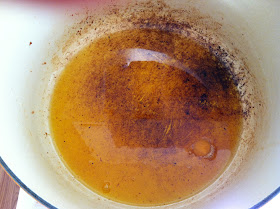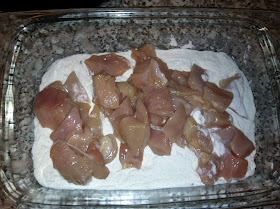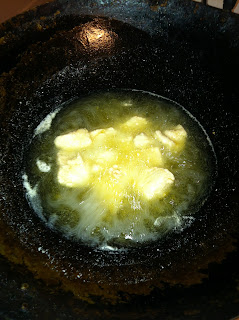.JPG)
I went to New Orleans for the first time a few months back. It was such a fantastic place! Decadent, decadent food! Delicious and quite rich! One of the best things I had here was Gumbo. Gumbo is essentially a spicy stew of tomatoes, celery, bell peppers and onions, mixed with Cajun spices and meat of some kind. Spicy and savory, its absolutely delicious. Its great when you have a whole bunch of leftover veggies around. I had picked up a Gumbo spice mix in New Orleans, which I used in this recipe.
This was my second attempt at making a roux, the first was when I made
Homemade Japanese curry.
A roux is basically a paste of flour and butter. Or flour and oil. Or flour and animal fat. My conclusion: making a roux is rather difficult, requires constant attention, but well worth the effort. You really have to stir the roux constantly and keep an eye on it, otherwise the flour will burn and the whole thing is ruined! I found having
a good hand held wire whisk is indispensable! The key is to keep stirring until the flour is completely incorporated into the roux.
I adapted this recipe from
a blog called Annie's Eats. I say adapted because, I screwed up the recipe! It really pays to pay attention and not cut corners...lesson learned the hard way. First, I decided to cut the onions in a food processor, because onions always make me cry and I broke my trusty pair of onion goggles. The result was that the onions were very finely cut, almost a mush! Its would have been better to just chop the onions by hand.
Second, quite by accident, I changed the process of making this. Her original recipe says to cook the bacon with a little oil. Once the bacon is done, and the fat renders out, you are supposed to add the chicken and cook it in the bacon fat (yum!). Then add the sausage. After removing all of the meat from the pot, you then make a roux from the remaining chicken, bacon and sausage fat. Add a little chicken stock to the roux. Then you stir celery, green pepper, onion, garlic into the roux, add stock and add your meat back in and slow cook for 1.5 hours. Done. Simple. Delicious. Right?
That would seem like the logical way of doing things. Things started out okay, but then went quickly wrong!

I started with cooking the bacon, which came out perfect. Removed the bacon, and had some nice bacon fat. Unfortunately, I didn't have enough bacon fat, so I added some chicken fat. Adding the chicken fat was actually quite nice, because the fat had cayenne pepper, harissa and other nice spices in it. So I was feeling pretty happy with myself about the chicken fat! I was really worried about making the roux. I just went ahead and added my flour to make the roux from the chicken and bacon fat. The roux was coming out beautifully, which I was quite proud of. Look at that color, look at that consistency!
When things go wrong
And that is when the mistakes started piling up. It was then I realized I made my first mistake: In my haste, I forgot all about cooking the chicken in the fat! I realized my mistake too late, but I figured I could still salvage the situation. I would just cook the chicken in the chicken broth with the spices. The chicken wouldn't have that delicious crispiness that frying brings, but in the end everything would be okay, right?

I guess that would have been okay, if I stopped there. But, no, I went on! For some reason, that I cannot even think of, I added my vegetables to the beautiful roux, which turned out to be a horrible mistake! Things went bad fast! The roux broke down, and got all mushy, pasty and nasty. My beautiful roux turned into some sort of nightmare
bete noire. The liquid started evaporating, leaving me with a roux that was going to start burning any minute and vegetables that were not even slightly cooked! Yuk! My beautiful roux went from the above picture to this in a matter of minutes.


I added chicken stock immediately and started stirring it with a wire whip immediately! The vegetables started getting stuck in the wire whip, which was bad.
It took a good five minutes of whipping, but the roux finally started coming together in a good way.
Once the roux had a good consistency, I went back to the recipe. I added the chicken pieces and slow cooked them in the liquid broth. The sausages were already cooked, so I just added them in at the end. Added the spices, the tomatoes and the okra and let it cook for 30 minutes. It turned out great in the end! I added the bacon as a topping while I was serving it with rice.
What I have learned from this experience:
1. I will always stir my roux. I will always stir my roux. I will always stir my roux.
2. Cook your bacon first. Remove and cook your sausages. Remove the sausages, add some chicken fat and then cook your chicken. Remove the cooked chicken. The combined oil and fat from the bacon, sausages and chicken should be enough fat to make the roux. If not, add some additional chicken fat. The fat from my fried chicken works well, and gives it a great orange color and pepper flavor!
Ingredients
6 oz bacon, cut
2 lbs chicken (preferably legs or thighs, bone-in or breasts in a pinch. I used breasts, skin on)
Salt
1 lbs spicy andouille sausage (Merguez sausage or spicy Italian sausage crumbled would work too)
1/2 cup chicken fat (I used the leftover chicken fat from my
pan fried southern chicken, which lent a delicious amber color to my dish. Peanut oil or regular vegetable oil would work fine as well)
1 cup flour
2 green peppers, seeded and diced
4 stalks celery, diced
1 large onion, diced
4 garlic cloves, minced
2 tablespoons tomato paste
4 cups
rich dark chicken stock
1/2-1 lbs okra, sliced
Cajun Spice Mix
Garnish:
3 green onions, chopped
Fresh parsley, chopped
Directions (The Right way of doing it!)
Cook the meat
In a large stockpot (I used my trusty
Le Creuset Oval French Oven), add a little bit of oil and cook the bacon over medium-high heat until the bacon is cooked and crispy. Remove the bacon with a slotted spoon and drain on paper towels.
At this point, add the chicken to the pot. Cook skin side down for a few minutes. Sprinkle some salt on the side that is facing up. Cook for 4-5 minutes, then flip. If there is not enough oil when you are cooking the chicken, add some chicken fat. Remove the chicken with a slotted spoon when it is done.
Making the Roux

You should have about 3/4 of a cup of oil and fat in the pan (add more oil or chicken fat if you don't have enough). Heat the oil over medium heat.

As it gets hot, stir in the flour. Whisk the flour constantly with a wire whisk. This should take several minutes. Reduce the heat to medium-low, and continue to stir.


While the roux is cooking, bring the chicken stock to boil in a separate pot. When the roux has reached the color you want it, add the garlic and tomato paste to it.
Using a ladle, gradually add the hot chicken stock to the roux. Continue to ladle in stock, and stirring constantly with a whisk. It helps to have a second pair of hands: someone can ladle and someone can stir (Big thanks to my beautiful wife Robyn!). The roux should thin out and be more soup like.
Add the tomato paste to the roux and whisk. Stir in half of the cajun spice mix. Taste. Add more of the cajun spice mix if needed.
Stir fry your vegetables
In a separate fry pan, stir fry the diced green pepper, celery and onion in more chicken fat. Stirfry for about 5 minutes. Stir in the garlic and continue to cook for about 1 minute more, until the garlic turns golden brown. Transfer all of it (including any remaining chicken fat) to the roux.
Add the chopped okra to the roux soup. Cook for a few minutes.
Add the cooked chicken to the roux soup. Add the sausage to the roux soup.
Bring the whole soup to a boil then reduce heat to low. Cover and cook for five minutes. About once a minute, give it a quick stir to make sure nothing is sticking to the bottom and burning.
Sprinkle the bacon on top of the soup. Garnish with green onion and fresh parsley.
 This is part of my continuing series on Jumbalaya.
This is part of my continuing series on Jumbalaya. In your trusty slow cooker, combine the chicken, sausage, tomato, onion, green pepper, celery and chicken broth. Stir in the oregano, Cajun spice mix, hot sauce, bay leaves, thyme and rice.
In your trusty slow cooker, combine the chicken, sausage, tomato, onion, green pepper, celery and chicken broth. Stir in the oregano, Cajun spice mix, hot sauce, bay leaves, thyme and rice. Slow cook on LOW for 7 hours, or on HIGH for 3 hours.
Slow cook on LOW for 7 hours, or on HIGH for 3 hours.

.JPG)
.JPG)
.JPG)
.JPG)

.JPG)
.JPG)
.JPG)
.JPG)









.JPG)



.JPG)

.JPG)
















